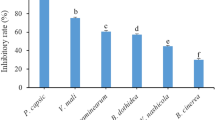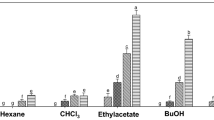Abstract
Crude ethanol extracts and six organic solvent fractions of 10 Thai medicinal plants were evaluated for their antifungal activity against Alternaria brassicicola in laboratory and under greenhouse conditions. The results showed that the ethanol extracts of Coscinium fenestratum, Piper betle, Syzygium aromaticus and Zingiber cassumunar displayed complete mycelial growth inhibition of A. brassicicola at a concentration of 0.1%. Meanwhile, the crude ethanol extract and methanol fraction obtained from the stems of C. fenestratum revealed the greatest inhibition against A. brassicicola at 10%, forming inhibition zones 2.55–2.58 cm in diameter. In the greenhouse experiments, crude ethanol extracts of C. fenestratum and P. betle at 1% significantly (P < 0.05) reduced the disease incidence at up to 67%, indicating promising preventive and curative activities against A. brassicicola. This activity is similar to that of iprodione, a widely used commercial fungicide. Interestingly, Illicium verum extract showed a greater curative effect (58% disease reduction) than protective effect (47% disease reduction). Because the C. fenestratum extract showed the highest activity against the black spot pathogen both in vitro and under greenhouse conditions, its methanol fraction was further analyzed by spectroscopic techniques. We found that berberine is a key active substance inhibiting mycelial growth of A. brassicicola. The results of this study showed the potential of Thai medicinal plants as alternatives to the use of synthetic fungicides for controlling black spot in Chinese kale caused by A. brassicicola.



Similar content being viewed by others
References
Ali, I., Khan, F. G., Suri, K. A., Gupta, B. D., Satti, N. K., Dutt, P., Afrin, F., Qazi, G. N., & Khan, I. A. (2010). In vitro antifungal activity of hydroxychavicol isolated from Piper betel L. Annals of Clinical Microbiology and Antimicrobials, 9, 7–9.
Amein, T., Wright, S. A., Wikstrom, M., Koch, E., Schmitt, A., Stephan, D., Jahn, M., Tinivella, F., Gullino, M. L., Forsberg, G., Werner, S., Wolf, J., & Groot, S. P. C. (2011). Evaluation of non-chemical seed treatment methods for control Alternaria brassicicola on cabbage seeds. Journal of Plant Diseases and Protection, 118, 214–221.
Avenot, H., Simoneau, P., Iacomi-Vasilescu, B., & Bataille-Simoneau, N. (2005). Characterisation of mutations in the two component histidine kinase gene AbNIK1 from Alternaria brassicicola that confer high dicarboximide and phenylpyrrole resistance. Current Genetics, 47, 234–243.
Chantawannakul, P., Puchanichanthranon, T., & Wongsiri, S. (2005). Inhibitory effects of some medicinal plant extracts on the growth of Ascosphera apis. Acta Horticulturae, 678, 183–189.
Curtis, H., Noll, U., Störmann, J., & Slusarenko, A. J. (2004). Broad-spectrum activity of the volatile phytoanticipin allicin in extracts of garlic (Allium sativum L.) against plant pathogenic bacteria, fungi and Oomycetes. Physiology and Molecular Plant Pathology, 65, 79–89.
Dethoup, T., Kumla, D., & Kijjoa, A. (2015). Mycocidal activity of crude extracts of marine-derived beneficial fungi against plant pathogenic fungi. Journal of Biopesticides, 8(2), 107–115.
Dhamgaye, S., Devaux, F., Vandeputte, P., Khandelwal, N. K., Sanglard, D., Mukhopadhyay, G., & Prasad, R. (2014). Molecular mechanisms of action of herbal antifungal alkaloid berberine, in Candida albicans. PLoS One, 9(8), e104554.
Didwania, N., Sadana, D., & Trivedi, P. C. (2013). Antibacterial activity of a few medicinal plant against Xanthomonas campestris pv. campestris. International Journal of Research in Pharmaceutical Sciences, 4(2), 177–182.
Domadia, P. N., Bhunia, A., Sivaraman, J., Swarup, S., & Dasgupta, D. (2008). Berberine targets assembly of Escherichia coli cell division protein FtsZ. Biochemistry, 47(10), 3225–3234.
Fernández-Rodríguez, S., Sadyś, M., Smith, M., Tormo-Molina, R., SkjØth, C. A., Maya-Manzano, J. M., Silva-Palacios, I., & Gonzalo-Garijo, T. (2015). Potential sources of airborne Alternaria spp. spores in South-west Spain. Science of the Total Environment, 533, 165–176.
Fu, W., Tian, G., Pei, Q., Ge, X., & Tian, P. (2017). Evaluation of berberine as a natural compound to inhibit peach brown rot pathogen Monolinia fracticola. Crop Protection, 91, 20–26.
Huang, R., & Levy, Y. (1995). Characterization of iprodione-resistant isolates of Alternaria brassicicola. Plant Disease, 79(8), 828–833.
Humpherson-Jones, F. M. (1988). Alternaria brassicae (Berk.) Sacc. & A. brassicicola (Schwein.) Wiltshire. In I. A. Smith, J. Dunez, R. A. Lelliott, D. H. Phillips, & S. A. Archer (Eds.), European handbook of plant diseases (pp. 366–368). Oxford: Blackwell Scientific Publications.
Iwasa, K., Moriyasu, M., & Nader, B. (2000). Fungicidal and herbicidal activities of berberine related alkaloids. Bioscience, Biotechnology and Biochemistry, 64, 1998–2000.
Jesonbabu, J., Spandana, N., & Aruna Lakshmi, K. (2012). In vitro antimicrobial potentialities of chloroform extracts of ethanomedicinal plant against clinically isolated human pathogens. International Journal of Pharmacy and Pharmaceutical Sciences, 4(3), 624–626.
Kishore, G. K., & Pande, S. (2005). Integrated management of late leaf spot and rust diseases of groundnut (Arachis hypogaea L.) with Prosopis juliflora leaf extract and chlorothalonil. International Journal of Pest Management, 51(4), 325–332.
Krämar, W., & Schirmer, U. (2007). Modern crop protection compounds V.2: Fungicides. Germany: WILEY-VCH Verlag GmbH & Co. KGaA.
Lee, C. H., Lee, H., Jeon, J. H., & Lee, H. S. (2005). In vivo antifungal effects of Coptis japonica root-derived isoquinoline alkaloids against phytopathogenic fungi. Journal of Microbiology and Biotechnology, 15(6), 1402–1407.
Lee, S. O., Park, I. K., Choi, G. J., Lim, H. K., Jang, K. S., Cho, K. Y., Shin, S. C., & Kim, J. C. (2007). Fumigant activity of essential oils and components of Illicium verum and Schizonepeta tenuifolia against Botrytis cinerea and Colletotrichum gloeosporioides. Journal of Microbiology and Biotechnology, 17(9), 1568–1572.
Limsuwan, S., Subhadhirasakul, S., & Voravuthikunchai, S. P. (2009). Medicinal plants with significant activity against important pathogenic bacteria. Pharmaceutical Biology, 47, 683–689.
Madduluri, S., Babu Rao, B., & Sitaram, B. (2013). In vitro evaluation of antibacterial activity of five indigenous plants extract against five bacterial pathogens of human. International Journal of Pharmacy and Pharmaceutical Sciences, 5, 679–684.
Muto, M., Takahashi, H., Ishihara, K., Yuasa, H., & Huang, J. W. (2005). Control of black leaf spot (Alternaria brassicicola) of Crucifers by extracts of Black Nightshade (Solanum nigrum). Plant Pathology Bulletin, 14, 25–34.
Nashwa, S. M. A., & Abo-Elyou, K. A. M. (2012). Evaluation of various plant extracts against the early blight disease of tomato plants under greenhouse and field conditions. Plant Protection Science, 28(2), 74–79.
Nowicki, M., Nowakowska, M., Niezgoda, A., & Kozik, E. (2012). Alternaria black spot of crucifers: symptoms, importance of disease, and perspectives of resistance breeding. Vegetable Crops Research Bulletin, 76(1), 5–19.
Oka, K., Ishihara, A., Sakaguchi, N., Nishino, S., Parada, R. Y., Nagakiri, A., & Otani, H. (2015). Antifungal activity of volatile compounds produced by an edible mushroom Hypsizygus marmoreus against phytopathogenic fungi. Journal of Phytopathology, 163, 987–996.
Pane, C., Fratiannii, F., Parisi, M., Nazzaro, F., & Zaccardelli, M. (2016). Control of Alternaria post-harvest infections on cherry tomato fruits by wild pepper phenolic-rice extracts. Crop Protection, 84, 81–87.
Panwar, V., Gangwar, R. K., Javeria, S., & Yadav, R. S. (2013). Antifungal efficacy of fungicides and bio-control agents against leaf spot pathogens, Alternaria alternata. Current Discovery, 2(2), 128–133.
Paulert, R., Smania, J. A., Stadnik, M. J., & Pizzolatti, M. G. (2007). Antimicrobial properties of extracts from the green seeweed Ulva fasciata Delile against pathogenic bacteria and fungi. Algological Studies, 123, 123–130.
Phachonpai, W., Wattanathorn, J., Wannanon, P., Thipkaew, C., Sripanikulchai, B., & Muchimapura, S. (2012). Coscinium fenestratum protects against ethanolinduced neurodegeneration in adult rat brain. American Journal of Pharmacology and Toxicology, 7(3), 81–88.
Pinto, J. M. A., Souza, E. A., & Oliveira, D. F. (2010). Use of plant extracts in the control of common bean anthracnose. Crop Protection, 29, 838–842.
Rai, R. V., Rajesh, P. S., & Kim, H. M. (2013). Medicinal use of Coscinium fenestratum (Gaertn.) Colebr.: an short review. Oriental Pharmacy and Experimental Medicine, 13(1), 1–9.
Rajeshkumar, R., & Sundararaman, M. (2012). Emergence of Candida spp. and exploration of natural bioactive molecules for anticandidal therapy–status quo. Mycoses, 55(3), e60–e73.
Sanit, S. (2016). Antifungal activity of selected medicinal plants against Alternaria species: the pathogen of dirty panicle disease in rice. Journal of Medicinal Plant Research, 10(15), 195–201.
Shrisha, D. L., & Raveesha, K. A. (2014). Antibacterial activity of Coscinium fenestratum against phytopathogenic bacteria and isolation, characterization of antibacterial active principle. Journal of Pure and Applied Microbiology, 8(2), 1727–1733.
Sibi, G., Wadhava, R., Singh, S., Dhananjaya, K., Ravikumar, K. R., & Malleasha, H. (2013). Biological control of onion black mold by Indian culinary spices under in vitro conditions. Asian Journal of Pharmaceutical and Clinical Research, 6(2), 156–158.
Singburaudom, N. (2015a). Hydroxychavicol from Piper betel leave is an antifungal activity against plant pathogenic fungi. Journal of Biopesticides, 8(2), 82–92.
Singburaudom, N. (2015b). The alkaloid berberine isolated from Coscinium fenestratum is an inhibitor of phytopathogenic fungi. Journal of Biopesticides, 8(1), 28–36.
Tamilselvi, S., Venkatasubramanian, P., Kannan, K. P., & Vasanthi, N. S. (2014). Studies on estimation of berberine and antimicrobial activity of different extracts of Berberis aristata DC. Asian Journal of Microbiology Biotechnology and Environmental Stress, 16(3), 669–672.
Tuli, L., Jha, R., Pandey, V. B., & Singh, U. P. (2001). Antifungal activity of chaerophylline and berberine isolated from Corydalis species. Mycobiology, 29(2), 100–103.
Ujvary, I. (2002). Transforming natural products into natural pesticides-experience and expectations. Phytoparasitica, 30, 439–442.
Valentão, P., Gonçalves, R. F., Belo, C., Pinho, P. G., Andrade, P. B., & Ferreres, F. (2010). Improving the knowledge on Piper betle: targeted metabolite analysis and effect on acetylcholinesterase. Journal of Separation Science, 33, 3168–3176.
Wahyudi, Y. O. & Ichiura, H. (2012). Significant feeding deterrent of berberine from Tali kuning (Tinospora dissitiflora Diels) against two subterranean termites Coptotermes formosanus Shiraki and Reticulitermes speratus Kolbe. Wood Research Journal, 3, 18–22.
Yang, C. J., Zhang, X. G., Shi, G. Y., Zhao, H. Y., Chen, I., Tao, K., & Hou, T. P. (2011). Isolation and identification of endophytic bacterium W4 against tomato Botrytis cinerea and antagonistic activity stability. African Journal of Microbiology Research, 5(2), 131–136.
Yoon, M.-Y., Kim, Y. S., Ryu, S. Y., Choi, G. J., Choi, Y. H., Jang, K. S., Cha, B., Han, S.-S., & Kim, J.-C. (2011). In vitro and in vivo antifungal activities of decursin and decursinol angelate isolated from Angelica gigas against Magnaporthe oryzae, the causal agent of rice blast. Pesticide Biochemistry and Physiology, 101, 118–124.
Acknowledgements
This work was financially supported by the Kasetsart University Research and Development Institute under the project “Searching for antifungal compounds from medicinal plants against plant pathogenic fungi for development natural fungicides”.
Author information
Authors and Affiliations
Corresponding author
Ethics declarations
Conflict of interest
The authors declare no conflict of interest.
Ethical approval
This article does not contain any studies with human participants or animals performed by any of the authors.
Informed consent
Informed consent was obtained from all individual participants included in the study.
Electronic supplementary material
ESM 1
(DOCX 2628 kb)
Rights and permissions
About this article
Cite this article
Dethoup, T., Songkumarn, P., Rueangrit, S. et al. Fungicidal activity of Thai medicinal plant extracts against Alternaria brassicicola causing black spot of Chinese kale. Eur J Plant Pathol 152, 157–167 (2018). https://doi.org/10.1007/s10658-018-1460-5
Accepted:
Published:
Issue Date:
DOI: https://doi.org/10.1007/s10658-018-1460-5




